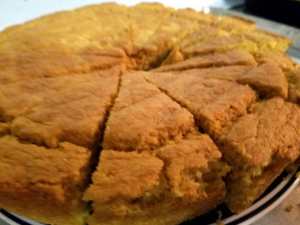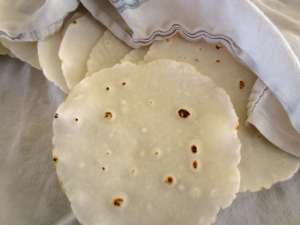 I apologize for the quality of this picture: I was in a hurry when I was taking it. So, while I took three separate pictures, none of them turned out very well.
I apologize for the quality of this picture: I was in a hurry when I was taking it. So, while I took three separate pictures, none of them turned out very well.
Anyway, it’s getting to be a bit colder here, which is excellent chili weather. The best thing to eat with chili is cornbread (of course) so I make a lot of it. The trouble is that most recipes call for sour cream and milk, so I decided to try using some alternative ingredients.
This is the (super delicious) result. The recipe is a little bit of work, but it’s totally worth it.
Skillet Cornbread
1 1/2 cups plain coconut milk yogurt
1/2 cup almond milk
1/4 cup avocado oil
1/4 cup coconut oil
1 teaspoon baking powder
1 teaspoon baking soda
3/4 teaspoon teaspoon salt
2 large eggs
- Adjust oven racks to lower-middle and middle positions and heat oven to 450°F. Place a 10 inch skillet (preferably cast-iron) on the middle rack and heat for 10 minutes.
- Spread cornmeal on a rimmed baking sheet and toast on the bottom rack until fragrant and lightly browned, about 5 minutes.
- Transfer toasted cornmeal to a large bowl and whisk in yogurt and milk. Set aside.
- When skillet is hot, add the avocado oil and heat for another 5 minutes.
- Using potholders, remove the skillet from the oven and add the coconut oil to the hot avocado oil, swirling gently to incorporate. Pour hot oil mixture into the cornmeal mixture and whisk until combined (resist the urge to scrape the extra oil out with a spatula). Whisk in baking powder, baking soda and salt. The batter will immediately start to rise. This is normal.
- Whisk in the eggs then pour the batter into the hot skillet and place on the middle rack with a clean cookie sheet underneath to catch any drips that may occur.
- Bake for 12-15 minutes, or until the top begins to brown and crack and the sides are golden brown, rotating skillet halfway.
- Allow the bread to cool for 5 minutes in the skillet before flipping it out onto a cooling rack.
- Cool for 10 minutes and then serve.
Notes
- This works best with yogurt that’s past it’s date, which basically means it is more sour than fresh yogurt. I usually keep an eye on the dairy discount section of the stores I frequent and make this whenever I pick up a tub of coconut milk yogurt that’s about to “go bad.”

